
Hedophyllum sessile
Sea Cabbage, Stipeless Kelp
28 May 2021
Botany Bay, Juan de Fuca Strait
Tide: 0.0 foot tide 09:23am PDT (measured at Port Renfrew Tidal station); -0.7 foot tide 10:18am PDT (measured at Sheringham Point Tidal Station)
Conditions: Wind, SW 20 – 30 km per hour, moderate southwesterly swell, overcast, no precipitation, 11˚C.
Phase of Moon: Waning Gibbous (approx. 54 hours into this phase at time of collection); (Previous Phase, Full Moon, 26 May 2021 at 4:13am PDT: Next Phase, Third Quarter, 2 June 2021 at 12:24am PDT.)
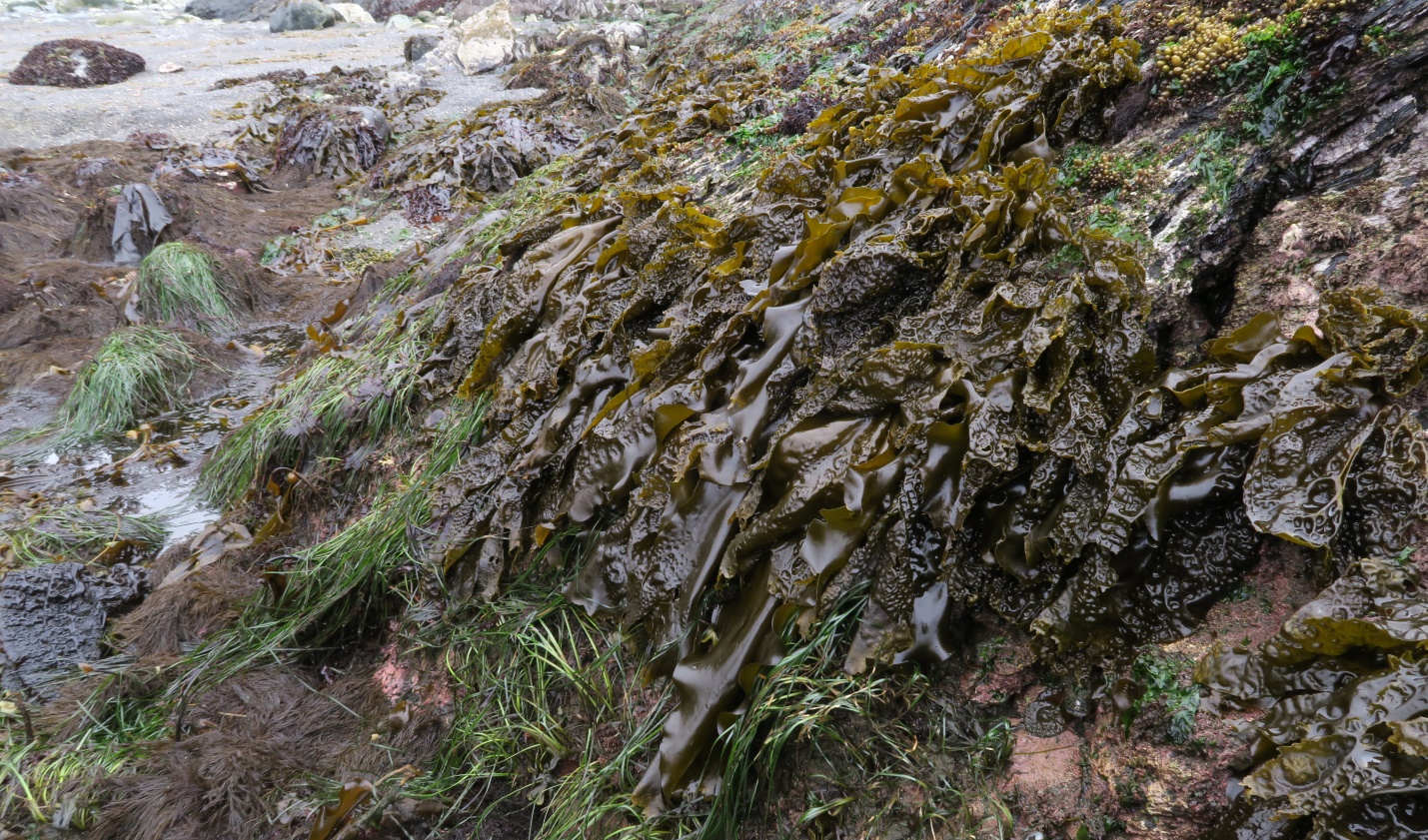
Figure 1: The expanse of bedrock at this site is well populated with macro algae – the largest and most dominant seen at this very low tide is Sea Cabbage, Hedophyllum sessile. The blades can be quite varied in their appearance, and they arise directly from their holdfast with no stipe; as such they seem to be a ‘part of’ the rock as well as the sea. Botany Bay, Strait of Juan de Fuca, B.C., Canada. May 28, 2021. Photo ID 27327 ©Seaweedwhisperings.com
Person 1:
Happy with its lot in life.
Shorter thallus than most other kelp species – that’s just fine.
Many thalli very crinkled but some with very smooth blades.
Blade pattern highly varied – some mostly crinkled with bullae of various shapes, a few have erratically-direction-ed rib-like ridges, and some have just a few parallel lines of bullae on an otherwise smooth blade.
Many personalities, which one is authentic? Maybe it doesn’t know.
Multi-branched holdfast.
Happiest on vertical faces or edges of ledges.
Very conspicuous – exhibitionist.
From a distance the blades look totally intact, but close up you can see that every one of them is tattered at the margins.
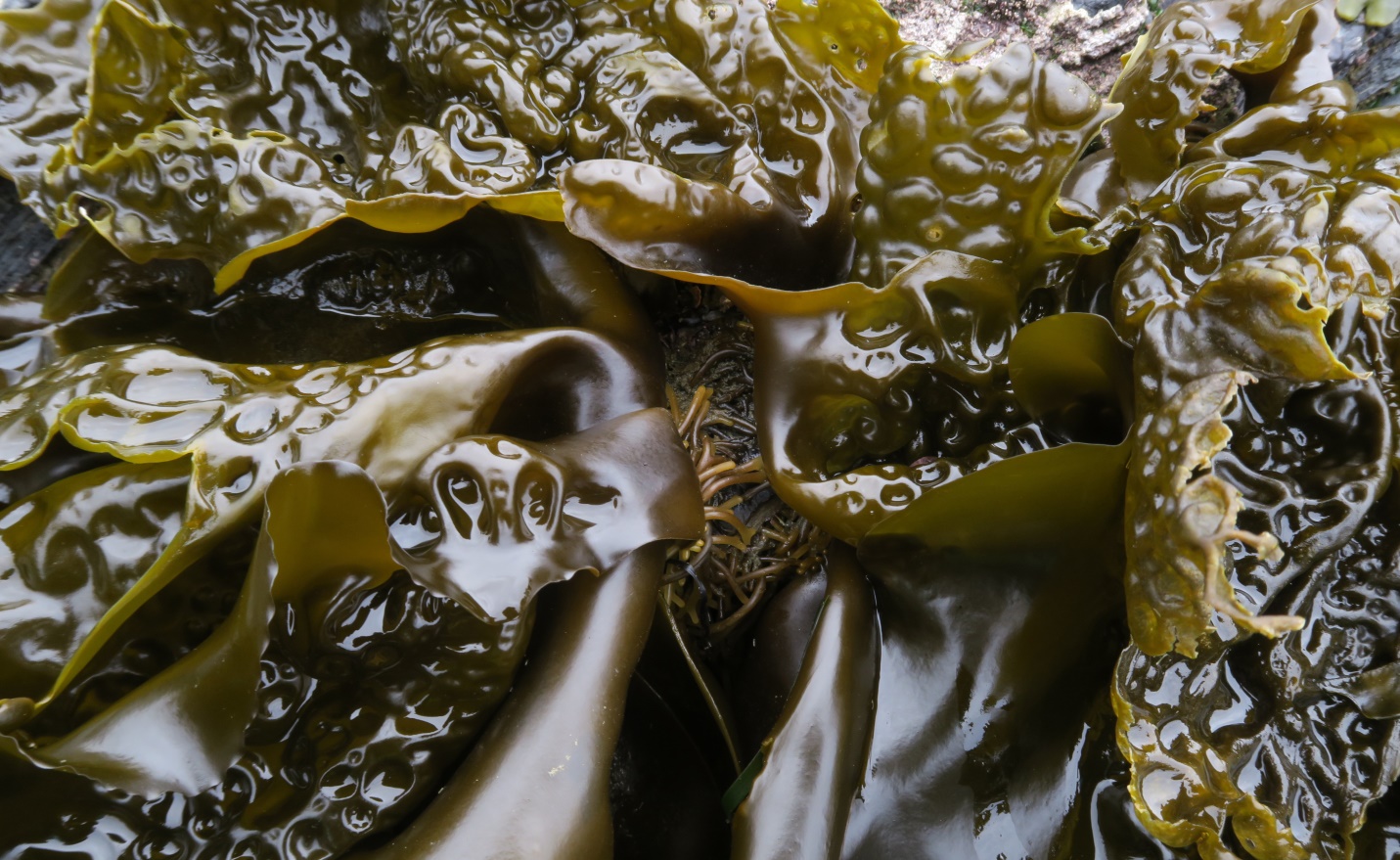
Figure 2: A closer view illustrates the textures and grooves of this “cabbage of the sea”. In the center of the photo the thin root-like branches (haptera) of the holdfast can be seen as they affix this kelp to the rocky substrate. Botany Bay, Strait of Juan de Fuca, B.C., Canada. May 28, 2021. Photo ID 27328 ©Seaweedwhisperings.com
Person 2:
You’re very happy here, growing on the bedrock “walls” of this channel.
Each plant a cluster of blades – and blades are either really bullate/puckered/indented or quite long and smooth and glossy.
None of your blades are undamaged but this doesn’t seem to bother. You still look and feel happy.
Leaves fold over on themselves and hold water, and those puckers form wells to hold water effectively.
I looked in a folded leaf and found a small kelp crab there. Perhaps your form of growth makes a safe haven for young sea critters, however in this interrelationship there is no benevolent effort on the part of the Sea Cabbage; it is not intentional, but rather a happy coincidence.
Holdfast has many branches, clinging to rocks, and then your blade blossom out broadly and with deep undulations – a lot of surface area.
Holdfast seems tiny in comparison to what it has to hold (the large blades).
You’re happy, even content but I find for some reason this has me feeling rather “bored” with you fairly quickly. My eye wanders to your neighbors, to other stories, to other colors and forms and energies.
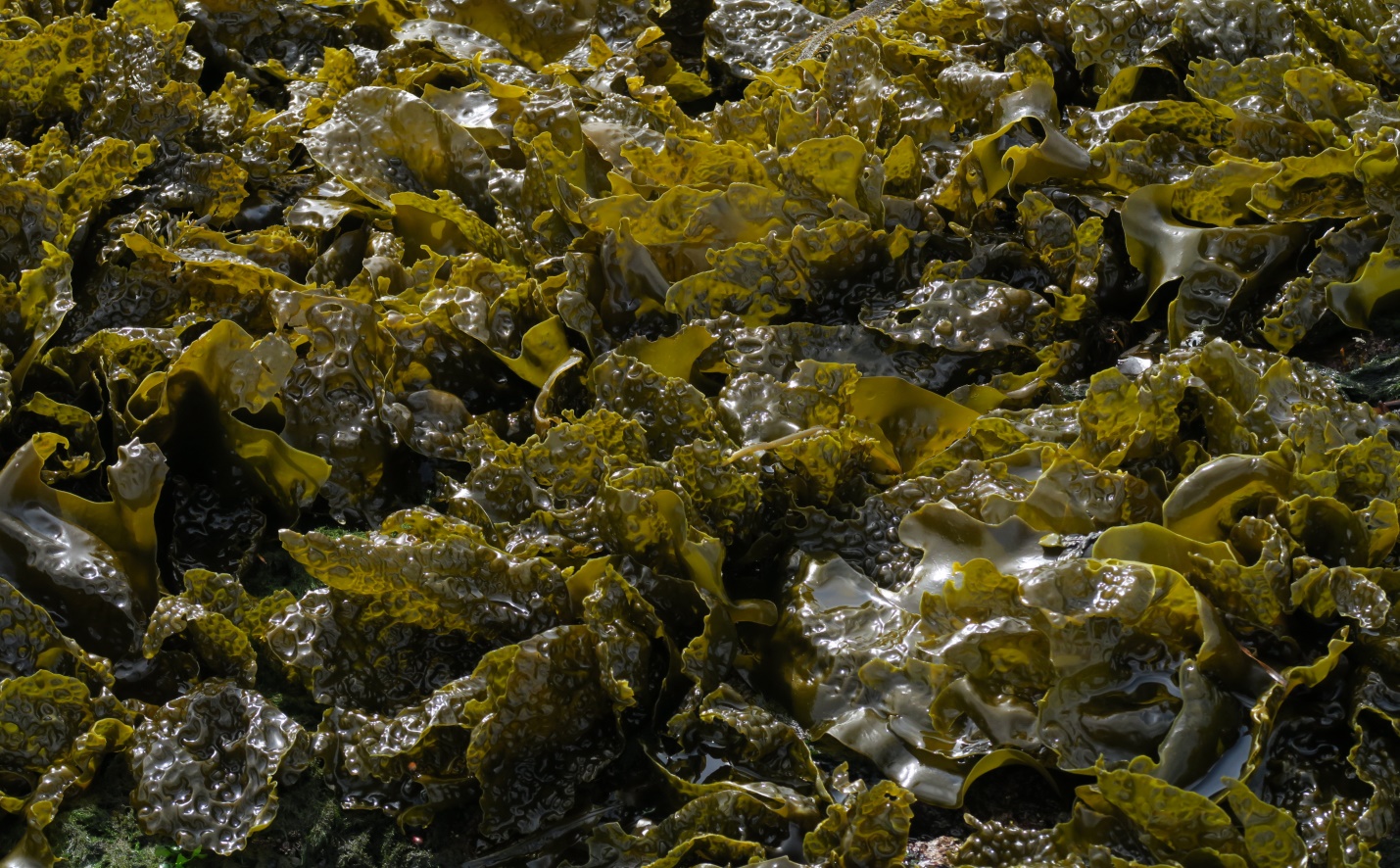
Figure 3: When Sea Cabbage does well, it really does well! This patch is growing on a bedrock shelf in an area of good current in mid-spring; the deeply bullate and undulate blades have been likened by some authors to an ‘elephants ear’ – whatever associations you draw, it is distinctive. Harling Point, Strait of Juan de Fuca, B.C. Canada. June 5, 2020. Photo ID 27329 ©Seaweedwhisperings.com
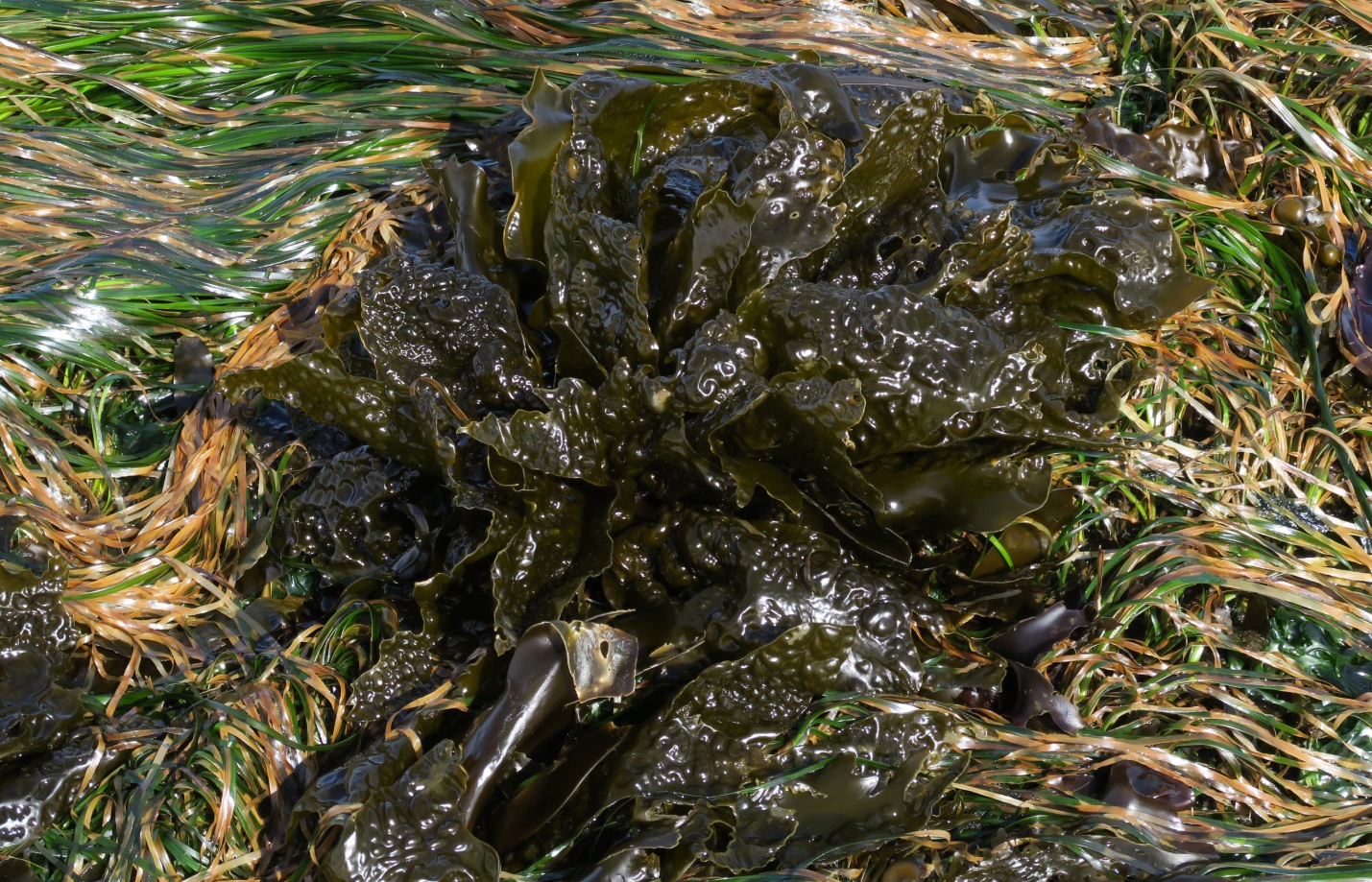
Figure 4: A lone head of “Sea Cabbage” is seen growing here – the resemblance to savoy cabbage of the food crop ‘land’ variety is evident. Harling Point, Strait of Juan de Fuca, B.C. Canada. June 12, 2021. Photo ID 27330 ©Seaweedwhisperings.com
Discussion:
Sea Cabbage, you seem to be almost a part of the rock as much as a part of the sea – is this because your stipe connects your big blades so very closely with the substrate? Many other types of seaweed grow close to the rocks but not many are as large as you, Hedophyllum sessile. With this growth habit of yours you “stay close to home” and seem very content to be there. You do not seem to have any desire for a long stipe, or even a shorter one, that would carry you up and some distance away from your “roots” as is the case with many other kelps.
Even though you don’t venture far, you are very conspicuous, Sea Cabbage. You are in no way shy or bashful, but you do seem to have a rather inconsistent outward presentation. Somehow you seem to simply attempt growing this way or that way or maybe yet again in this other way, too..., and no matter what you do, the currents and surf and wind and other forces of your environment do impact you. You end up tattered or split or trimmed back or munched on by chitons and herbivores. These “lessons” don’t seem to impact you – you are happy as you are. Your wounds don’t seem to be taken in; no, not at all. Instead you seem to have the skill to free them on the very next tide and this leaves you newly washed clean and free to continue as you are.
You are called “Sea Cabbage” and it seems that this name reflects a few traits. You may, with some of your various morphologies, resemble a savoy cabbage of the land plants (Brassica oleracea), but it seems also that the moniker of ‘cabbage’ fits you in another way. Cabbages are humble food plants; they are not exotic or sophisticated yet they are nutritious and valuable in their own right. Our “cabbage of the sea”, Hedophyllum sessile, feels much like this. There is no sophistication or manipulation or even the desire for such complicated ways or behaviors – Sea Cabbage is not so much meek and low-ranking as it is totally unconcerned with such evaluations. Its energy is wonderfully and most times blissfully ignorant of such comparisons and measures.
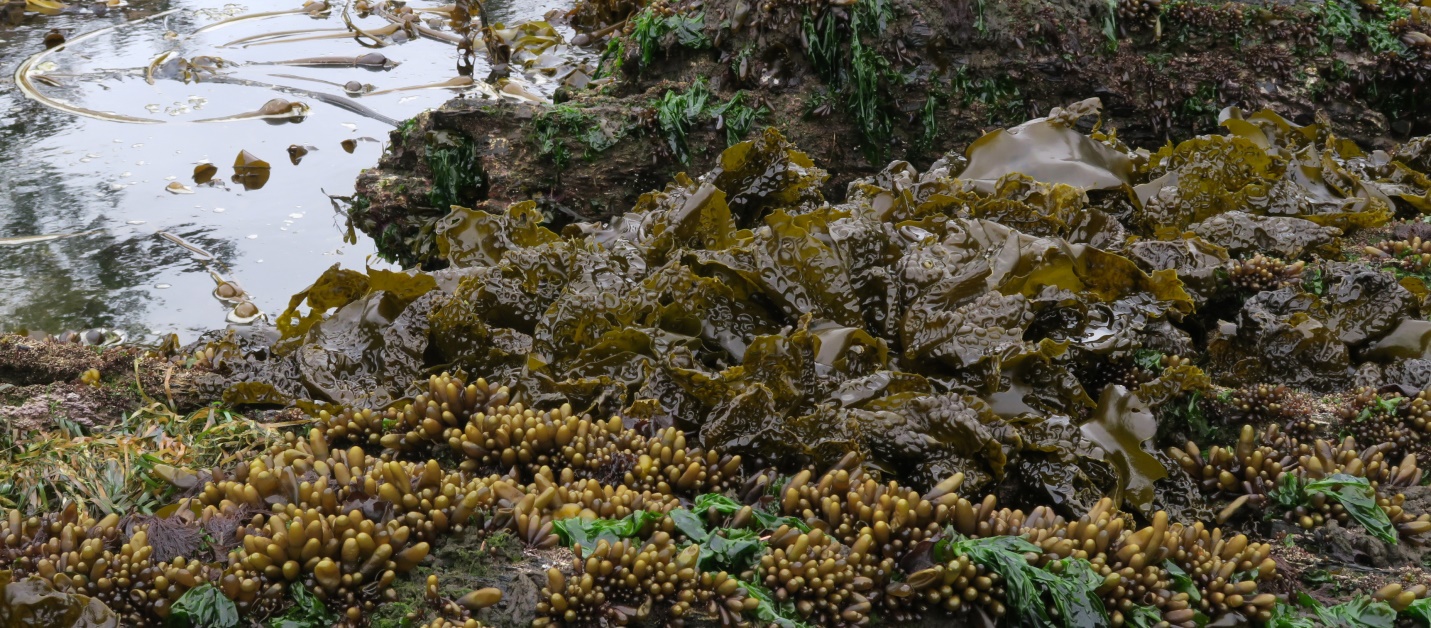
Figure 5: Here Sea Cabbage shares the low intertidal zone with a few more macro algae species. In a relatively sheltered location this seaweed typically grows with many undulations and bullations. Botany Bay, Strait of Juan de Fuca, B.C., Canada. May 28, 2021. Photo ID 27331 ©Seaweedwhisperings.com
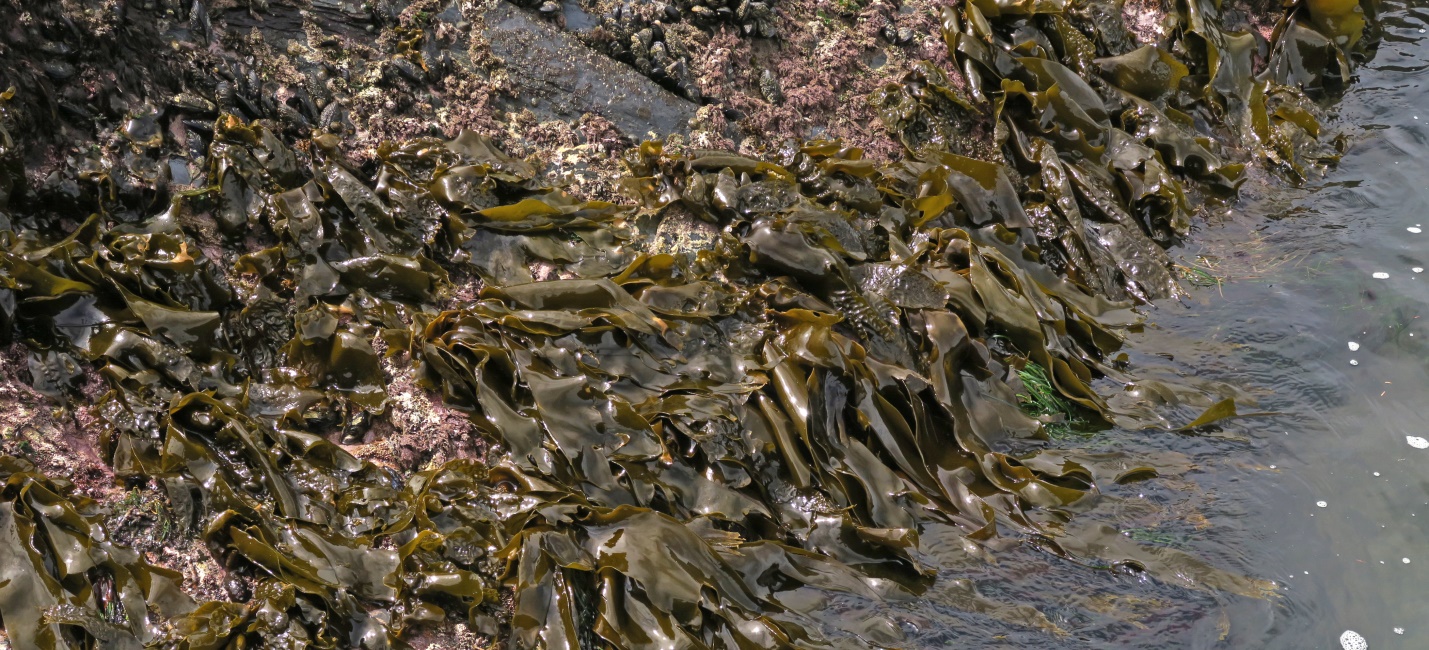
Figure 6: On the edge of this surge channel Sea Cabbage is growing in its smoother and less undulate form; some long reaches of the blades trail into the water and these easily approach 1.5 meters in length. Higher wave action seems to dictate this morphology. Botany Bay, Strait of Juan de Fuca, B.C. Canada. April 12, 2020. Photo ID 27196 ©Seaweedwhisperings.com
Biology & Natural History Information:
Description:
This brown alga is unique among the kelps in that the mature seaweed has no stipe between the holdfast and the blades. When young, the ovate blade does have a short stipe, but the stipitate region soon disappears and the profusely branched root-like holdfast then anchors the blades to rock. The blades are somewhat thick and grow between 30 and 150 cm long and up to 80 cm wide (although they usually are smaller). They may be smooth or highly undulate and puckered with bullae. Even if bullate, the Sea Cabbage blade is always smooth near the holdfast. In spite of their relative thickness, the blades are fairly fragile and become torn and tattered with age, and blades become markedly furled and often deeply dissected, especially in areas of active surf. The overall coloration of Sea Cabbage ranges from a bright olive green/brown to warm caramel brown and even dark chocolate brown.
Habitat:
This seaweed grows on rock in the mid and lower intertidal areas of exposed and semi-exposed coastlines. It can become a dominant species in areas with moderate wave exposure, carpeting areas with its presence. In wave exposed areas the blades are generally smoother with many splits but in protected areas they blade surface is wavy and often far more textured.
Distribution:
Hedophyllum sessile ranges from the Commander Islands in Russia east through the Aleutian Islands, and south along the entire west coast of North America to Monterey County, California, U.S.A.
Remarks:
In British Columbia and Washington stage black Katy chitons, Katharina tunicata, feed on Sea Cabbage more than any other kelp. Other grazers, such as sea urchins, feed on different kelp species and not sea cabbage. Wherever the urchins are present Sea Cabbage thrives in large canopies, but if absent, Sea Cabbage is quickly out-competed for space by other large brown kelp species.
Classification:
Phylum: Ochrophyta
Class: Phaeophyceae
Order: Laminariales
Family: Laminariaceae
Genus: Hedophyllum
Species: Hedophyllum sessile (C.Agardh) Setchell 1901
Previous name(s): Saccharina sessilis (C.Agardh) Kuntze 1891, Laminaria sessilis C.Agardh 1824
![]()